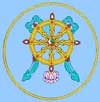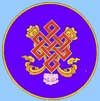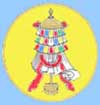 The Eight Auspicious Symbols or Signs of Good Fortune, known as “Ashtamangala” in Sanskrit, are very popular in Tibet and China and are found in temples and on dharma instruments, banners, doors, brocades, rugs, and many items. They represent particular teachings of the Buddha and as such serve to grant auspiciousness or good fortune to those who see them or have them. The Ashtamangala are the rare right turning white conch shell, the lotus flower, the dharmachakra (dharma wheel), the parasol, the endless knot, the golden fishes, the victory banner, and the treasure vase. Shown here is a tipi at the Holy Vajrasana Temple that is adorned with these signs.
The Eight Auspicious Symbols or Signs of Good Fortune, known as “Ashtamangala” in Sanskrit, are very popular in Tibet and China and are found in temples and on dharma instruments, banners, doors, brocades, rugs, and many items. They represent particular teachings of the Buddha and as such serve to grant auspiciousness or good fortune to those who see them or have them. The Ashtamangala are the rare right turning white conch shell, the lotus flower, the dharmachakra (dharma wheel), the parasol, the endless knot, the golden fishes, the victory banner, and the treasure vase. Shown here is a tipi at the Holy Vajrasana Temple that is adorned with these signs.
The Conch Shell (Skt. shankha; Tib. dung dkar):The rare white conch which coils to the right symbolizes the deep, far-reaching and melodious sound of the dharma teachings, which being appropriate to different natures, predispositions and aspirations of disciples, awakens them from the deep slumber of ignorance and urges them to accomplish their own and others’ welfare. It also stands for the fame of the Buddha’s teaching, which spreads in all directions like the sound of the conch trumpet.The conch shell has survived as the original horn trumpet since time immemorial. Ancient Indian epics describe how each hero of mythical warfare carried a mighty white conch shell, which often bore a personal name. It is one of the main emblems of Vishnu, and his conch bears the name of Panchajanya, meaning ‘having control over the five classes of beings.’ Arjuna’s (hero of the Mahabharata) mighty conch was known as Devadatta, whose triumphant blast brought terror to the enemy. As a proclaiming battle horn, the conch is akin to the bugle. It is an emblem of power, authority and sovereignty whose blast is believed to banish evil spirits, avert natural disasters, and scare away poisonous creatures. Today, the conch is used in Tibetan Buddhism to call together religious assemblies. During the actual practise of rituals, it is used both as a musical instrument and as a container for holy water. The right turning conch shells which spiral to the right in a clockwise direction are a rarity and are considered especially sacred. The right-spiralling movement of such a conch is believed to echo the celestial motion of the sun, moon, planets and stars across the heavens. The hair whorls on Buddha’s head spiral to the right, as do his fine body hairs, the long curl between his eyebrows (urna), and also the conch-like swirl of his navel. Imagery of the Buddha usually displays a group of three curving conch-like lines on His neck to represent the Buddha’s deep and resonant voice, through which He introduced His followers to the path of the dharma. In addition to the Buddha’s throat, the conch also appears as an auspicious mark on the soles, palms, limbs, breast or forehead of a divinely endowed being.
|
 |
The Lotus (Skt. padma; Tib. pad ma):The lotus flower symbolizes the complete purification of the defilements of the body, speech and mind, and the full blossoming of wholesome deeds in blissful liberation. It is considered to be a symbol of purity, or of pure or divine origination, for, although it has its roots in the mud of ponds and lakes, it raises its flower in immaculate beauty above the surface of the muddy water. The muddy water represents worldly defilements that we live with. The lotus refers to many aspects of the path with an open blossom signifying full enlightenment while a closed blossom or bud signifies the potential for enlightenment that is intrinsic in all sentient beings. The lotus does not grow in Tibet and so Tibetan art has only stylized versions of it. Nevertheless, it is one of Buddhism’s best recognized motifs since every important deity is associated in some manner with the lotus, either being seated upon it or holding one in their hands. Thus says the Lalitavistara (Biography of the Buddha), “the spirit of the best of men is spotless, like the lotus in the muddy water which does not adhere to it.” According to another scholar, “in esoteric Buddhism, the heart of the beings is like an unopened lotus: when the virtues of the Buddha develop therein, the lotus blossoms; that is why the Buddha sits on a lotus bloom.” Significantly, the color of the lotus too has an important bearing on the symbology associated with it: 1). White Lotus (Skt. pundarika; Tib. pad ma dkar po): This represents the state of spiritual perfection and total mental purity (bodhi). It is associated with the White Tara and proclaims her perfect nature, a quality which is reinforced by the color of her body. 2). Red Lotus (Skt. kamala; Tib: pad ma chu skyes): This signifies the original nature and purity of the heart (hrdya). It is the lotus of love, compassion, passion and all other qualities of the heart. It is the flower of Avalokiteshvara, the bodhisattva of compassion. 3). Blue Lotus (Skt. utpala; Tib. ut pa la): This is a symbol of the victory of the spirit over the senses, and signifies the wisdom of knowledge. Not surprisingly, it is the preferred flower of Manjushri,the bodhisattva of wisdom. 4). Pink Lotus (Skt. padma; Tib. pad ma dmar po): This the supreme lotus, generally reserved for the highest deity. Thus naturally it is associated with Shakyamuni Buddha.
|
 |
The Dharma Wheel (Skt. chakra; Tib. ‘khor lo):The golden wheel or dharmachakra symbolizes the auspiciousness of the turning of the precious wheel of Buddha’s doctrine, both in its teachings and realizations, in all realms and at all times, enabling beings to experience the joy of wholesome deeds and liberation. It has no beginning and no end and is at once in motion and at rest, expressing both the completeness and perfection of the teachings. It also symbolizes the three trainings of Buddhist practice: the hub stands for the training in moral discipline, through which the mind is supported and stabilized; the spoke stand for the application of wisdom in regard to emptiness, with which ignorance is cut off; the rim denotes the training in concentration, which holds the practice together. It is also a symbol for the Dharma’s power for swift spiritual transformation. The wheel evolved as a symbol of the Buddha’s teachings and as an emblem of the Chakravartin or wheel turner, identifying the wheel as the Dharmachakra or wheel of law. The Tibetan term for Dharmachakra (chos kyi’khor lo) literally means “the wheel of transformation.”The wheel’s swift motion serves as an apt metaphor for the rapid spiritual change engendered by the teachings of the Buddha. Hence, Buddha’s first discourse at the Deer Park in Sarnath is known as the first turning of the wheel of dharma. Likewise, his subsequent discourses at Vulture Peak near Rajagrha (Rajgir)and Shravasti are known as the second and third turnings of the wheel of dharma. The eight spokes can be viewed as symbols for the Eight-fold Path. True dharma kings possess magical dharma wheels that can perform various miracles. See holy Vajra Dharma Wheel.
|
 |
The Parasol (Skt. chattra; Tib. gdugs):The precious parasol or umbrella symbolizes the wholesome activity of protecting beings from illness, harmful forces, obstacles and so forth in this life, and all kinds of temporary and enduring sufferings of the three lower realms, and the realms of men and gods in future lives. It also represents the enjoyment of a feast of benefit under its cool shade. It is a sign of spiritual power. It also embodies the concept of wealth or even royalty, as one had to be rich to possess such an item and have someone carry it. It symbolizes the good fortune that comes to one who follows the path. Above the mountain is the dome of the sky. This is symbolized by the umbrella, whose important function is to cast a shadow, the shadow of protection. The dictionary defines a parasol as an umbrella used for protection from the sun. Thus its function is to protect exclusively from the heat rather than the rain – as the word parasol, meaning “to hold off the sun,” and umbrella, meaning “little shade,” similarly imply. The Sanskrit term chattra, also means mushroom, in an obvious reference to its shape. The parasol or umbrella is a traditional Indian symbol of both protection and royalty. The ability to protect oneself against inclement weather has always, in all cultures, been a status symbol. In Europe, until a few decades ago, a sunshade was a status symbol for society ladies. In Oriental thought, the fact that it protected the bearer from the scorching heat of the sun was transferred into the religious sphere as a “protection against the heat of defilements.” Thus the coolness of its shade symbolizes protection from the heat of suffering, desire, and other spiritually harmful forces. The dome of the umbrella is held aloft by a vertical handle (just like the mountain upholds the sky), which is identified with the ‘axis mundi,’ or the central axis upholding the world. The umbrella is carried above an important dignitary or the image of a deity, to indicate that the person or symbol below the umbrella is in fact the center of the universe, and also its spiritual support. Umbrellas seem to be especially important in processional rites, being like mobile temples. Thus, depictions of the Buddha often display an elaborate and large umbrella above his head. In Tibet, depending on their status, various dignitaries were entitled to different parasols, with religious heads being entitled to a silk one and secular rulers to a parasol with embroidered peacock feathers. Exalted personalities were sometimes entitled to both, and in processions, first a peacock parasol and then a silk one is carried after him. The Tibetan version of the parasol was adopted from its royal Indian and Chinese prototypes, and fashioned from a wooden, spoked frame with a domed silk cover and hanging silk pendants making up an overhanging skirt. The dome symbolizes wisdom, and the hanging skirt, compassion. Thus the composite form of the parasol signifies the union of these dual elements. Octagonal and square parasols are also common, representing the Noble Eightfold Path and the four directional quarters respectively.
|
 |
The Endless Knot (Skt. shrivatsa; Tib. dpal be’u):The endless or auspicious knot symbolizes the mutual dependence of religious doctrine and secular affairs as well as the twelve links of interdependent origination. Similarly, it represents the union of wisdom and method or skillful means, the great compassion. Having no beginning and no end, it also symbolizes the infinite knowledge of the Buddha. The intertwining of lines reminds us how all phenomena are conjoined and yoked together as a closed cycle of cause and effect. Thus the whole composition is a pattern that is closed on in itself with no gaps, leading to a representational form of great simplicity and fully balanced harmony. Since all phenomena are interrelated, the placing of the endless knot on a gift or greeting card is understood to establish an auspicious connection between the giver and the recipient. At the same time, the recipient is goaded to righteous karma, being reminded that future positive effects have their roots in the causes of the present. This is because the knot represents a connection, a link with our fates, binding us to our karmic destiny. Not surprisingly, this is one of the most favorite symbols in Tibetan Buddhism, and often occurs independently on its own.
|
 |
The Golden Fishes (Skt. suvarnamatsya; Tib. gser nya):This symbol consists of two fishes, which usually appear standing vertically with heads turned inwards towards each other. The golden fish symbolizes the auspiciousness of all living beings in a state of fearlessness, without danger of drowning in the ocean of sufferings, and migrating from place to place freely and spontaneously, choosing their rebirth and not bound by the chains of karma, just as fish swim freely without fear through water. The pair of fishes originated as an ancient pre-Buddhist symbol of the two sacred rivers of India, Ganga and Yamuna. Symbolically, these two rivers represent the lunar and solar channels, which originate in the nostrils and carry the alternating rhythms of breath or prana.
|
 |
The Victory Banner (Skt. dhvaja; Tib. rgyal mtshan):The victory banner symbolizes the victory of the activities of one’s own and others’ body, speech and mind over obstacles and negativities. It also stands for the complete victory of the Buddhist Doctrine over all harmful and pernicious forces. It incorporates the wish to bring about permanent, enduring happiness – both of the transient, worldly kind and of the ultimate kind. It is also seen as an adornment on temple roofs or the roofs of private homes that house a complete set of the canonical texts (Tripitaka). In Sanskrit, the banner or sign of victory is known as the dhvaja, meaning standard, flag or ensign. Originally, the victory banner was a military standard carried in ancient Indian warfare, and bore the specific insignia of its champion. The victory banner was adopted by early Buddhism as an emblem of the Buddha’s enlightenment, heralding the triumph of knowledge over ignorance. The flag of victory also denotes Buddha’s triumph over Mara, who personifies hindrances on the path to spiritual realization. Specifically, there are said to be four types of Maras, each one representing an individual hurdle on the path to spiritual progress. Cylindrical victory banners made of beaten copper are traditionally placed at the four corners of monastery and temple roofs. These signify the Buddha’s victorious dharma radiating to the four directions and also his triumph over the four Maras mentioned above.
|
 |
The Treasure Vase (Skt. nidhana kumbha; Tib. gter gyi bum pa):Also called the Vase of Inexhaustable Treasures, it is a fat-bellied vessel with a short, slim neck. On top, at the opening, there is a large jewel indicating that it is a treasure vase. The treasure vase symbolizes an endless rain of long life, wealth, and prosperity and all the benefits of this world and liberation. It is a sign of the fulfillment of both spiritual and material wishes. It symbolizes the inexhaustible riches available in the Buddhist teachings. Physically, the ‘vase of inexhaustible treasures’ is modelled on the traditional Indian clay water pot or kumbha with a flat base, round body, narrow neck and fluted upper rim. However much is removed from it, this vase remains perpetually full. Wealth vases, sealed with precious and sacred substances, are commonly placed upon altars and on mountain passes, or buried at water springs or other locations as offerings to the earth protectors, to promote peace and abundance, and where their presence is believed to attract wealth and bring harmony to the environment. In relation to Buddhism it specifically means the spiritual abundance of the Buddha, a treasure that did not diminish, however much of it he gave away. |
 |
